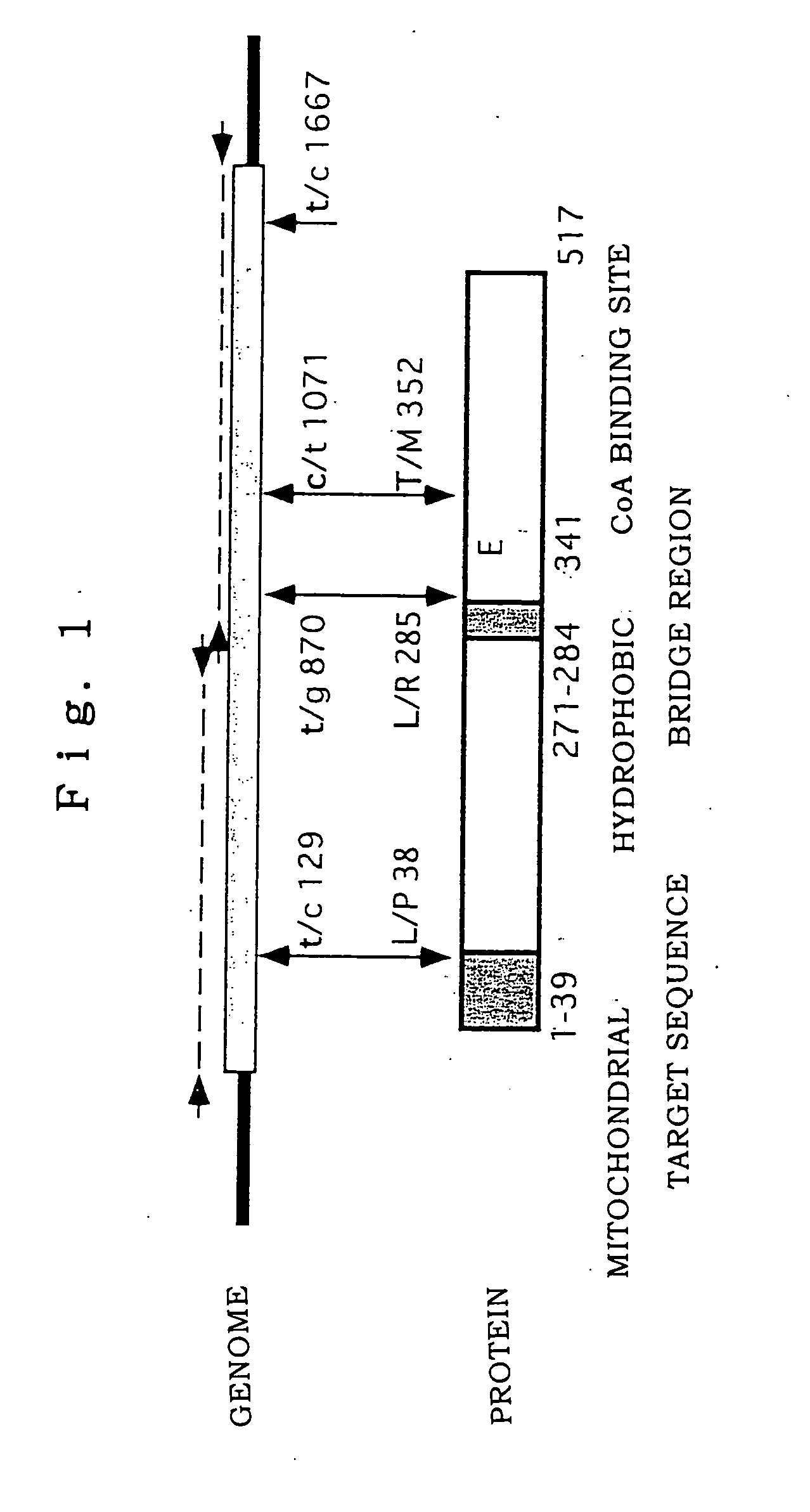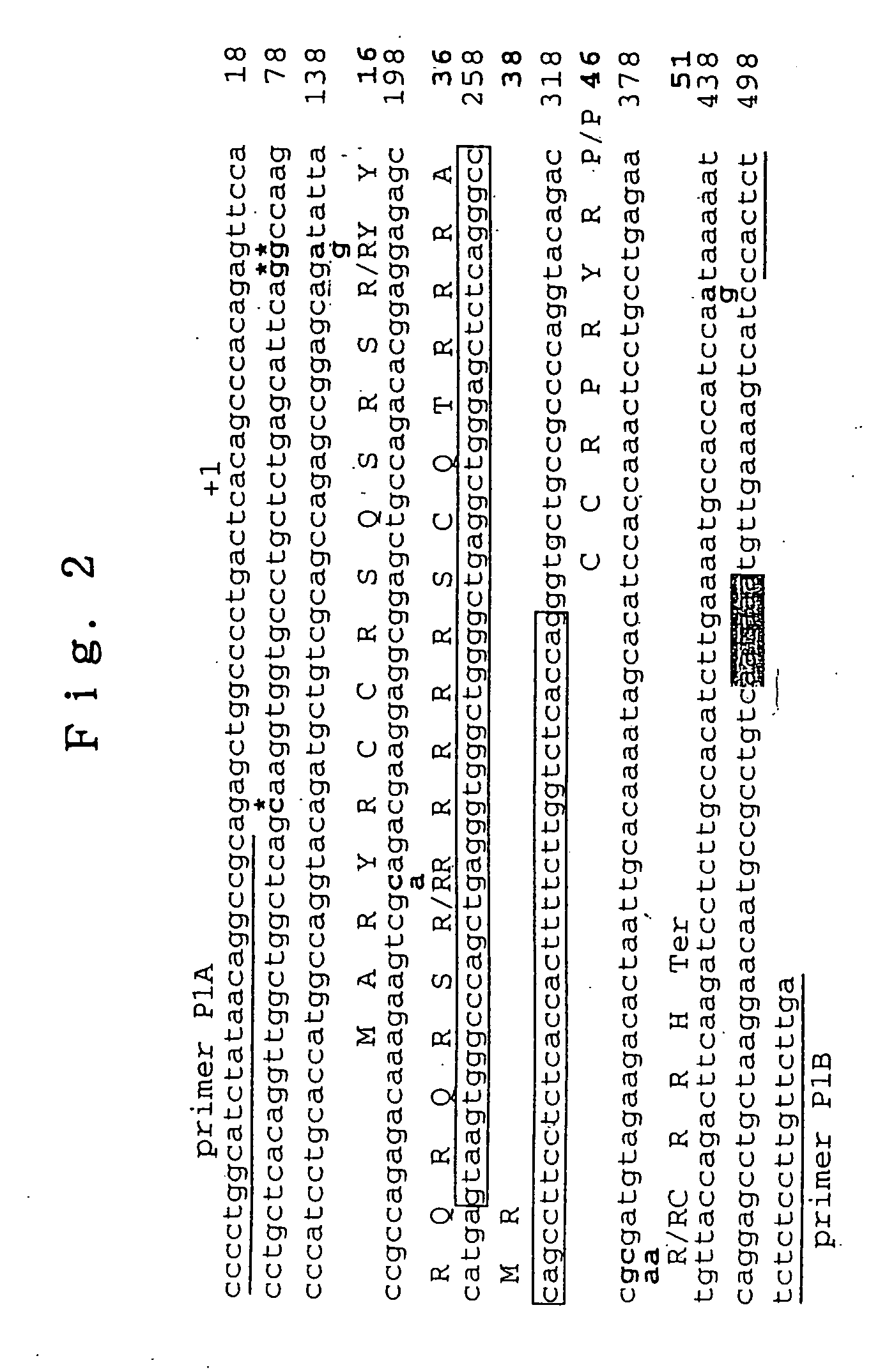Mouse spermatogenesis genes, human male sterility-associated genes and diagnostic system using the same
- Summary
- Abstract
- Description
- Claims
- Application Information
AI Technical Summary
Benefits of technology
Problems solved by technology
Method used
Image
Examples
example 1
Preparation of Mouse Total RNA
[0135] Each testis was excised from the following two groups of mice (C57BL / 6), 19 mice of 17 days old and 5 mice of 35 days old and collected into one capsule per group. Thereto was added 50 ml of 5.5M GTC solution (pH 7.5; 5.5M guanidine thiocyanate, 25 mM sodium citrate 2H2O, 0.5% (W / V) sodium lauryl sarconate, and 0.2M 2-mercaptethanol), and then the mixture was passed through a syringe with a 18G needle to break the cells. Then, the mixture was subjected to low-speed centrifugation and the supernatant was collected to remove precipitated cell fragments. Fifty milliliters of the collected supernatant was transferred into two tubes, in which 14 ml of CsTFA (cesium trifluoroacetate) solution was placed, in an amount of 25 ml each, followed by ultra-centrifugation (25,000 rpm, 15° C., 24 hours). RNA precipitated by the ultra-centrifugation was dissolved in 600 μl of 4.4M GTC solution / tube and then precipitated with ethanol. The precipitated RNA was di...
example 2
[0136] Preparation of Mouse mRNA[Poly(A)+]
[0137] Each of the total RNA in two tubes (two groups) in an ethanol-precipitated state obtained in Example 1 was rinsed with 70% (V / V) ethanol, and then 500 μl of the above TE / tube was added to dissolve the RNA, followed by heating at 65° C. for 5 minutes and rapid cooling on ice. Then, 500 μl of 1M NaCl / tube was added thereto and the resulting mixture was loaded on an oligo(dT)cellulose column [Type 3; manufactured by Collaborative Research] equilibrated with TE / NaCl (TE: 1M NaCl=1:1) beforehand. Each column was washed with 8 ml of the above TE / NaCl and then each was eluted with 0.5 ml of TE to achieve fractionation. This fractionation was repeated 5 times in total and a portion of each fraction was taken out and mixed with EtBr (ethidium bromide). Thereafter, the second fraction from which fluorescent radiation was observed under UV irradiation was adopted as an mRNA fraction. On the second fraction, the above operations from heating at 6...
example 3
Preparation of cDNA Library of 35 Day-Old Mouse Testis
[0138] It was prepared according to the procedure described in the following (1) to (6).
(1) Synthesis of First Strand (Preparation of Single-Stranded, ss-cDNA):
[0139] Seven micrograms of mRNA of 35 day-old mouse obtained in Example 2 was weighed out and distilled water was added thereto to make the total amount 7.5 μl, followed by heating at 65° C. for 5 minutes and then cooling with ice. Thereafter, the following reagents were added and mixed: 2.5 μl of 10×1st strand buffer [500 mM Tris-HCl (pH 8.3), 750 mM KCl, 30 mM MgCl2], 2.5 μl of 0.1M DTT (dithiothreitol), 1.5 μl of 1st strand methyl nucleotide mixture (10 mM dATP, dGTP and dTTP; and 5 mM 5-methyl-dCTP), 1 μl (1.6 μg) of linker primer [(GA) 10ACGCGTCGACTCGAGCGGCCGCGGACCG(T) 18], 0.5M1 of RNase inhibitor, and 7.5 μl of H2O. The whole was left on standing at room temperature for 10 minutes to effect annealing and then 2 μl of a reverse scriptase [manufactured by Seikagak...
PUM
| Property | Measurement | Unit |
|---|---|---|
| Length | aaaaa | aaaaa |
| Length | aaaaa | aaaaa |
| Length | aaaaa | aaaaa |
Abstract
Description
Claims
Application Information
 Login to View More
Login to View More - R&D
- Intellectual Property
- Life Sciences
- Materials
- Tech Scout
- Unparalleled Data Quality
- Higher Quality Content
- 60% Fewer Hallucinations
Browse by: Latest US Patents, China's latest patents, Technical Efficacy Thesaurus, Application Domain, Technology Topic, Popular Technical Reports.
© 2025 PatSnap. All rights reserved.Legal|Privacy policy|Modern Slavery Act Transparency Statement|Sitemap|About US| Contact US: help@patsnap.com



